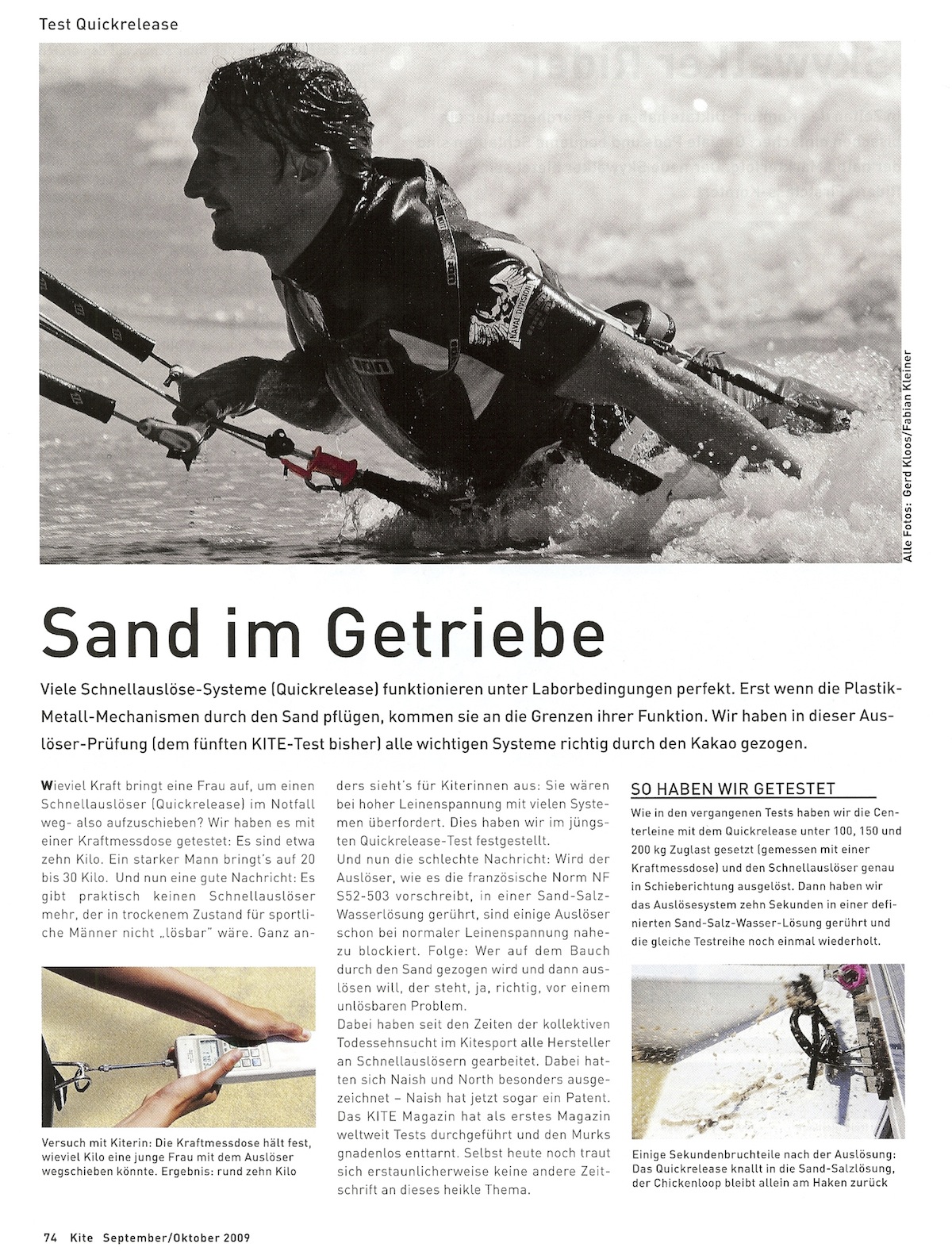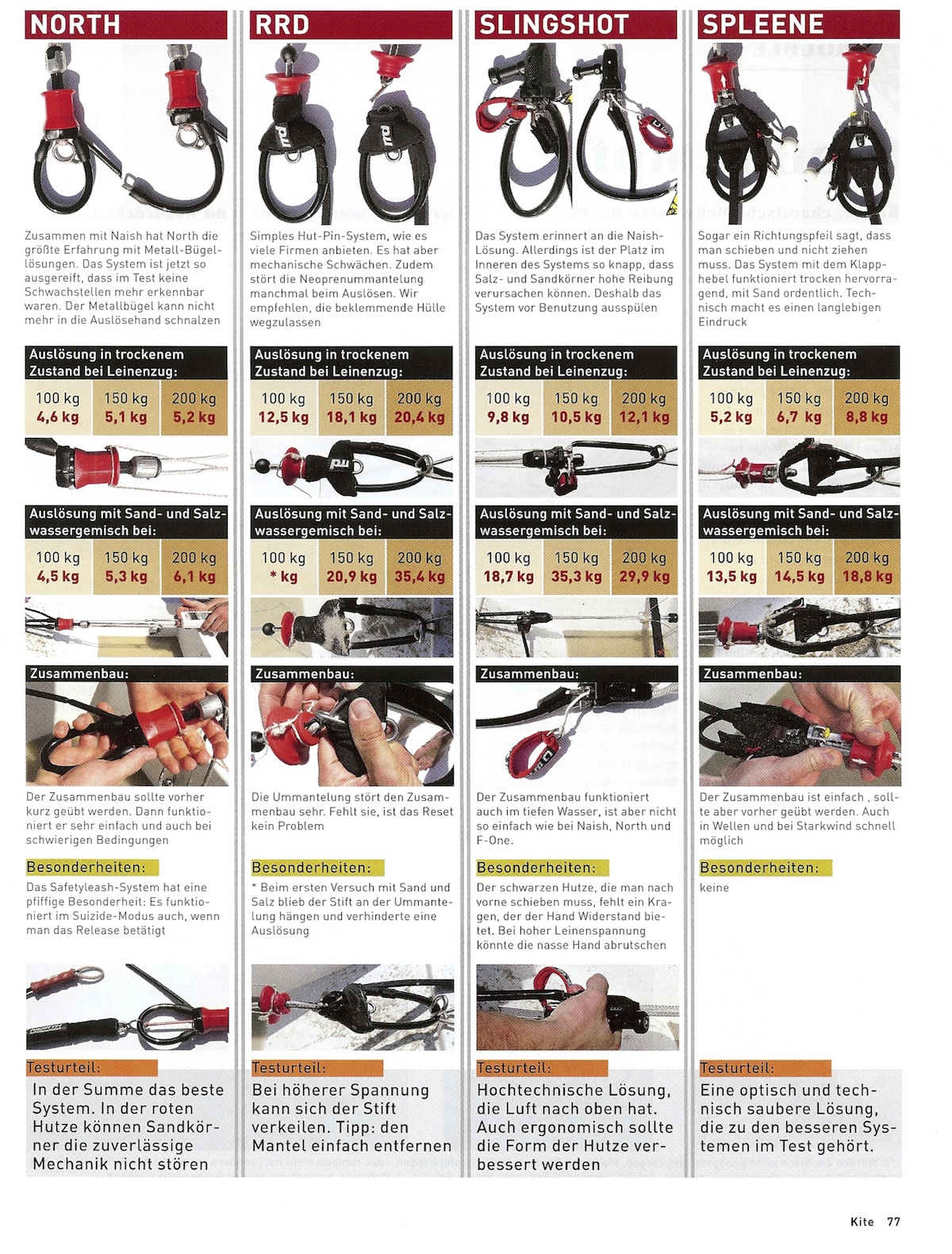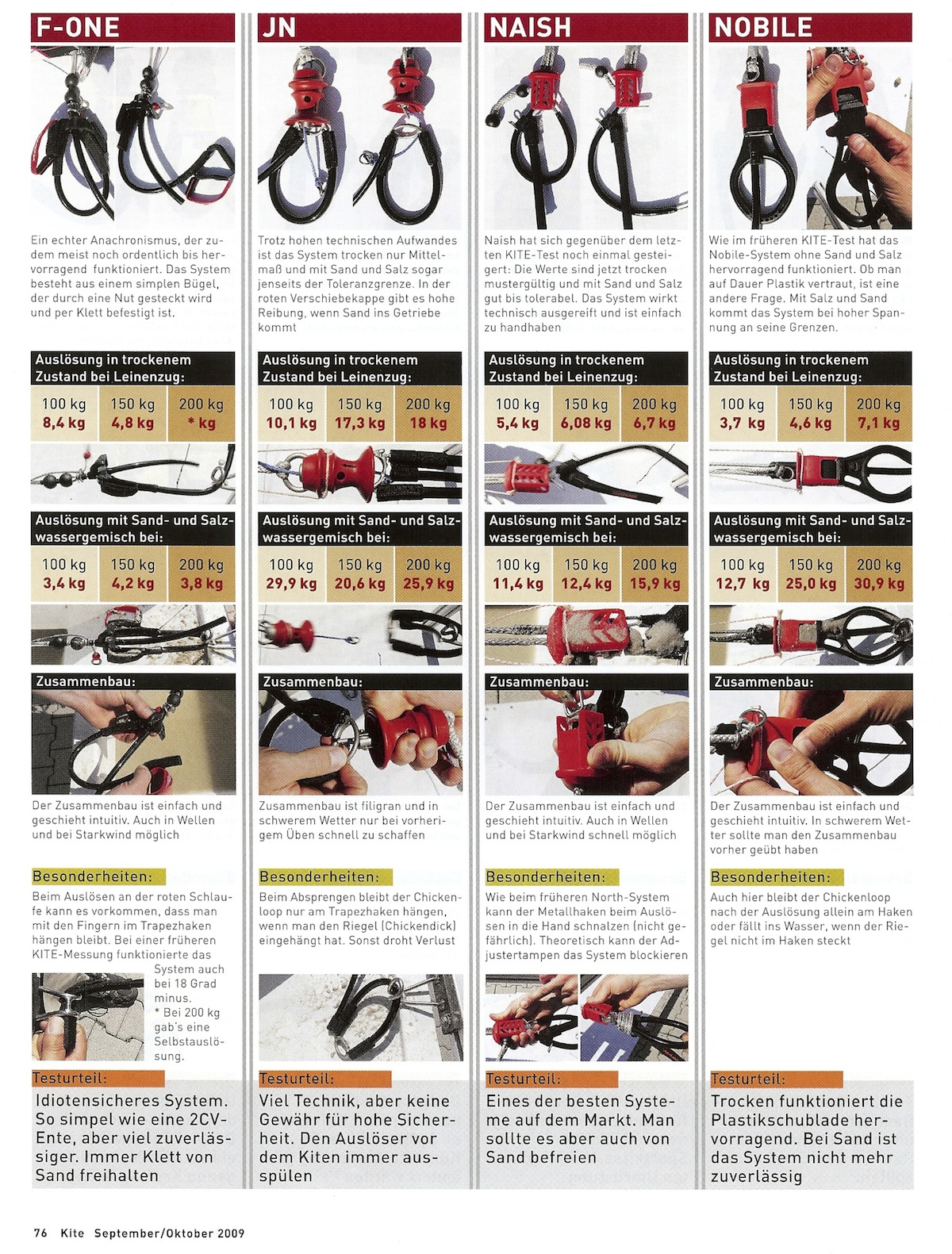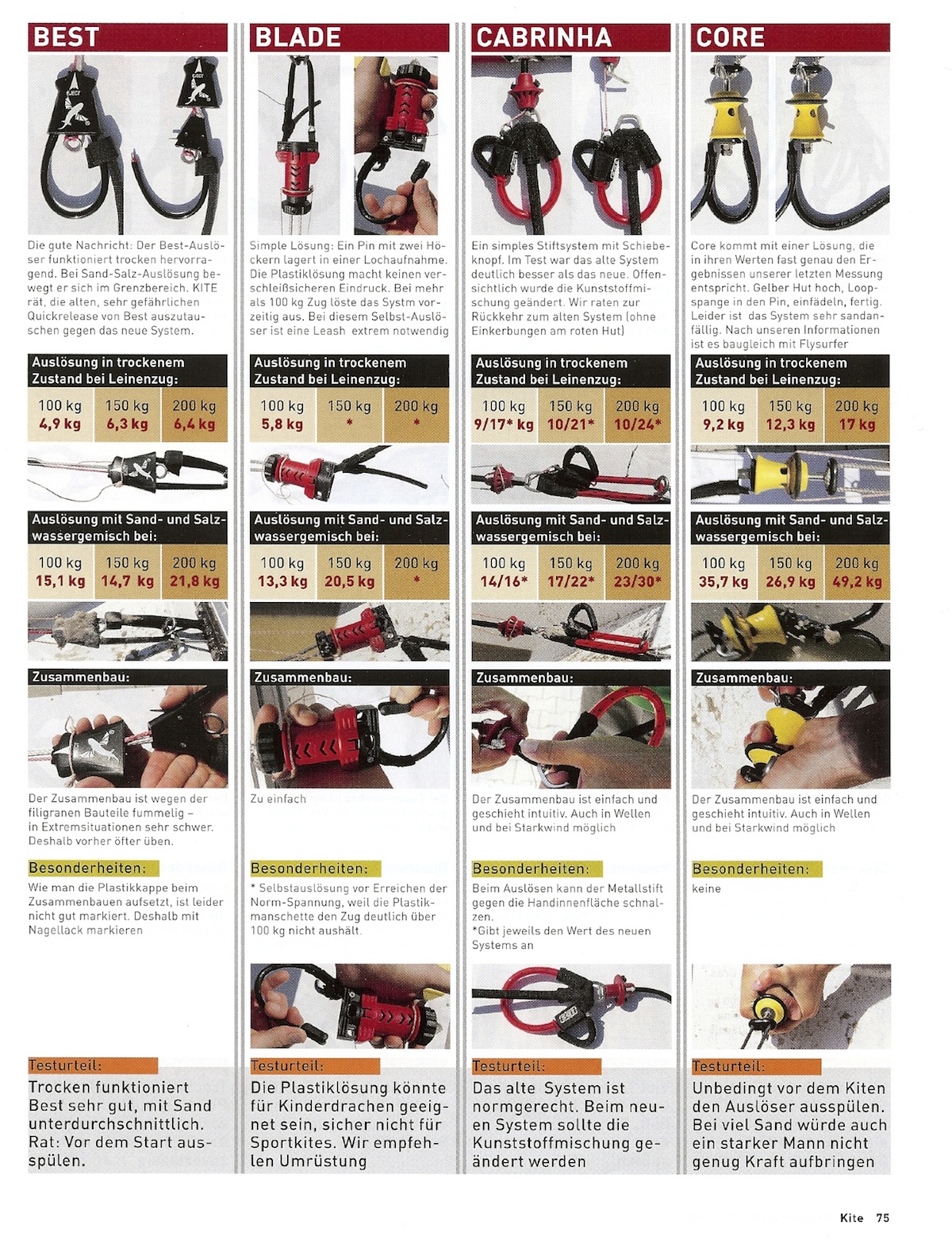

Yesterday's tragic accident got me thinking and I realized that I have no idea how the safety releases from other kite brands work. I would like to set up an overview of safety releases with a short description and a picture for the benefit of all of us. I would be great if others could contribute to cover as many brands as possible.
Here's how mine works:
Slingshot CSS (2010-2014)
Grab the red, black or red/black handle labelled "release" and push away from harness.

In German unfortunately but you can figure out the numbers - kg's of force to pull when loaded and the lower table is when covered in sand. I think this kind of test is more important - QRs are either push-away (the vast majority) or side-pull and rarely a velcro pull loop...




The important thing to take away from that table is that sand and salt up in your quick release generally make it harder to deploy it under load.
Therefore, regular rinsing of your QR in fresh water (after every session) and testing is essential.
If there is one thing the industry could do IMO, it would be to standardise QR systems across all different brands. Yes, individual kiters may have their preferences, and the underlying principles are all the same, but I just think it would be a good move across the industry.
Each different system inevitably has its pro's & cons, and of course, if someone happens to know why there are different styles of QR, I'm happy to hear, but IMO, it's time for standardisation.
In German unfortunately but you can figure out the numbers - kg's of force to pull when loaded and the lower table is when covered in sand. I think this kind of test is more important - QRs are either push-away (the vast majority) or side-pull and rarely a velcro pull loop...
Brilliant overview of release systems, thanks. Luckily I'm German, so if anyone need a translation of the non-english crap, I'll be happy to help.
The first test is done in a dry environment at different forces applied to the chicken loop (100, 150, 200kg). The force neccassary to trigger the release is noted below (e.g. North 4.6, 5.1, 5.2kg. The second test is done after soaking the release system in a sand/saltwater mixture for 10 mins.
What I take away from this is that there are massive differences in release force between the different brands, especially when sand/salt buildup jams the mechanism. Even though this is not very scientific (1 trial per scenario and sometimes inconsistent/unintuitive results) there is indication that the North system is superior even after the sand/saltwater bath.
The force required to trigger the release when it is blocked by sand is very high in most cases. Also bear in mind that this test does not account for wet hands on a slippery handle or just being tired after a long sesh. It is therefore vital to rinse your QR regularly and check the system before you launch.
The article is interesting, but out of date. It looks like around 2009. Most/all of the companies have changed their QR systems since then. It would be great to see an updated version. More data like this is needed in the kiteboarding market, so the buyer/user can make informed decisions.
It would be great if all product reviews were like that instead of the fluffy sponsor/advertiser/seller paid for reviews you normally get.
It would be great if all product reviews were like that instead of the fluffy sponsor/advertiser paid for reviews you normally get.
Amen, brother.
why put all that non English crap on this forum. ?
Ja, Und Specken Sie dick also???
In German unfortunately but you can figure out the numbers - kg's of force to pull when loaded and the lower table is when covered in sand. I think this kind of test is more important - QRs are either push-away (the vast majority) or side-pull and rarely a velcro pull loop...
Brilliant overview of release systems, thanks. Luckily I'm German, so if anyone need a translation of the non-english crap, I'll be happy to help.
The first test is done in a dry environment at different forces applied to the chicken loop (100, 150, 200kg). The force neccassary to trigger the release is noted below (e.g. North 4.6, 5.1, 5.2kg. The second test is done after soaking the release system in a sand/saltwater mixture for 10 mins.
What I take away from this is that there are massive differences in release force between the different brands, especially when sand/salt buildup jams the mechanism. Even though this is not very scientific (1 trial per scenario and sometimes inconsistent/unintuitive results) there is indication that the North system is superior even after the sand/saltwater bath.
The force required to trigger the release when it is blocked by sand is very high in most cases. Also bear in mind that this test does not account for wet hands on a slippery handle or just being tired after a long sesh. It is therefore vital to rinse your QR regularly and check the system before you launch.
Thanks!Does it say why the Blade QR doesn't have data points?
It would be great if the manufacturers got heir heads together and standardised primary and leash QR systems. I suspect no QR is notably more effective than the rest, they probably all cost the same to manufacturer and no particular standard leash is likely to impede kite development.
Pulling on a QR in a true emergency is driven by a flight or fight response, fine motor skills disappear as blood rapidly flows to the big muscles in the arms and legs. The only way to over-ride this is to generate muscle memory through familiarity and repetition, hundreds of times.
It becomes an issue if like me and many others you have accumulated 5 kites, 6 bar/lines and 4 different primary QR across 3 different brands, in general riding it's not an issue but in a ****-fight moments will be wasted thinking about the QR or looking down to see which QR I have hooked into, then mentally processing how to deploy it.
A classic example of standardisation is seat belts in cars, they are all pretty much the same, you never have to think about how to undone a seatbelt. It's so ingrained that you undo a seatbelt by going for the buckle on the side of your hip there are studies that show in an emergency evacuation of aircraft many passengers go for the buckle release at the side rather than the clasp at the front, In doing so critical moments are lost.
Someone correct me if im wrong, but it says they couldnt use the QR because it wasnt able to resist the pulling force and opened by its self.
Ha. Explains why i sometimes unhooked for no reason :P
Looking at some of the above numbers it's alarming to see that some releases when salted or full of sand can take up to 50 kg of force to release.
Although under a 200 kg load some have a normal release force of over 20 kg.
I normally reset mine every couple of rides as well as my safety just to make shure it's all good.
If i'm reading it correctly - quite interesting that the F-one velcro system, whilst much criticised, becomes progressively easier to release given more force (overpowered) and with sand etc. safer system??
I don't know the system but from the description the load bearing part is the velcro which parts more easily the higher the load. It actually released before reaching 200kg load in the dry test. I have no idea whether this load is relevant in normal operation e.g. a loop but if it is I'd rather have a system that does not release when I don't expect it.
For the sand test I'd guess the lower release force is due to sand and water weakening the velcro but as I said before 1 trial for each scenario has zero statistical relevance. Anyway it is definitely better than the usual marketing BS and serves as an indication how the different systems compare.
I've been riding 2-3 seasons now and I had never thought about the effect of salt and sand on QR until last week.
I pulled the QR expecting smooth operation and it simply didn't release. Had to pull it much harder than usual wasting another 2 seconds. Luckily I was only self landing. Now I know QR really needs to be checked up regularly.
A good reminder post!
I have made a pact, which started today. Before I launch now I activate the quick release and put it back together again then off I go. Also double checking bridals, lines etc. Just being that extra bit careful. Went for a kite today, must admit I was a little out of sorts and took it real easy and spent time having a little prayer or whatever you call it.
Couldn't imagine climbing a hill on equipment I hadn't checked and looked after
Who doesn't clean and check their kit after every session?
A Standardised QR system certainly has some merit.
With this latest tragedy the coroner is supposed to hold an inquest.
While hearing the accounts of those who valiently tried to release the kite on the beach before the tragic lofting event, the unfamiliar system may be identified as an issue.
I certainly would like to think that any or all of us who may need assistance (maybe because we are already injured) may have a better chance of successful assistance from our fellow kiters because everyone will be familiar (like drilled in it at lessons etc) with a universal QR system.
Bring it on I say.
A bit of topic, but it could be advantageous in incorporating more safety systems into the harness specifically for kite surfing with some sort of pull tab on the back of the harness. So in the event of someone laying face down in the water or on land not being able to activate their safety a potential rescuer could pull the tab and release the spreader bar and leash simultaneously releasing the powered kite completely. I don't know how the mechanics would work, but just a thought.
A classic example of standardisation is seat belts in cars, they are all pretty much the same, you never have to think about how to undone a seatbelt. It's so ingrained that you undo a seatbelt by going for the buckle on the side of your hip there are studies that show in an emergency evacuation of aircraft many passengers go for the buckle release at the side rather than the clasp at the front, In doing so critical moments are lost.
See, that is why I still drive my '65 Fastback Stang around, it has the aircraft style lap seat belts with the lift and release mechanism (and no seat belts in the back) - with the amount of flying I have done lately I want to make sure I am safe when I fly so need to be familiar with the seat belts :)
I've been riding 2-3 seasons now and I had never thought about the effect of salt and sand on QR until last week.
I pulled the QR expecting smooth operation and it simply didn't release. Had to pull it much harder than usual wasting another 2 seconds. Luckily I was only self landing. Now I know QR really needs to be checked up regularly.
A good reminder post!
I open and reset both my QR and my leash's release... most sessions, if not every. Always rinse my bar, and look over the kite as I'm setting up. Check pulleys are rolling smoothly... OCD helps in this sport, I think!
Guys here - they ride, dump their gear and then ride again. Check stuff? nah. For example, I frequently see people with the Naish-style leash so jammed up with sand it won't move, or hanging half open.
A Standardised QR system certainly has some merit.
With this latest tragedy the coroner is supposed to hold an inquest.
While hearing the accounts of those who valiently tried to release the kite on the beach before the tragic lofting event, the unfamiliar system may be identified as an issue.
I certainly would like to think that any or all of us who may need assistance (maybe because we are already injured) may have a better chance of successful assistance from our fellow kiters because everyone will be familiar (like drilled in it at lessons etc) with a universal QR system.
Bring it on I say.
I can't remember the guidelines off the top of my head as to what triggers a public inquest by the coroner but this one might not go that far. The death will be investigated by the Police Coronial Unit, that file will then go to the coroner for review. He/she can then complete a Record of Investigation of Death form, or go to a public inquest.
Deaths associated with kiting in WA in recent years are thankfully rare, I can only think of this one and the one up near Corronations last year(?). That one never went to an inquest that I'm aware of so getting the findings is tricky. Which leads purely to speculation as to whether the kiting caused the death or whether he had a heart attack or similar and the kiting was incidental to the death.
Just flicking through the accounts for Marc's there are so many factors to take into account.
Weather conditions, actual verses forecast.
Age and health of Marc,
kiting experience,
Location and it's suitability for kiting as far as wind conditions, wind eddies, obstructions and hazards, launching and landing
Age and condition of the kite, lines, harness, leash and quick releases
Suitability of the kite size to the forecast/actual weather
Did Marc make decisions that contributed to tripping and eventually getting lofted
Actions of bystanders that tried to grab Marc and his kite
Harness set-up, access to quick releases by Marc and the other kiters,
Protective equipment, was it worn, was it suitable, did it help, could it have helped if worn,
Efforts made by the bystanders to render first aid and medical interventional the scene.
I'd still advocate a standard QR but there is more to consider than just the design of QR and whether a helmet would have helped.
We also need to keep in mind the Coroner can only make recommendations if he holds an inquest. It's then up to manufacturers, importers, legislators or an organisation like Standards Australia plus us as individuals to take them on board and make and changes.
... I thought of this ages ago but had no idea how it could be implemented but a sort of fuse device that lets go when reached a predetermined pressure. You see fuses in all electrical equipment, so how can we put one in a bar/chickenloop/kite or even harness??
I've got no idea how you could 'fuse' a kite but wouldn't that be a good idea??? Making it independant of rider input is most important. When triggered, goes to one line sort of deal.
I assume it would have to be rider weight specific too so that complicates things too and not trigger prematurely when your pushing your riding (eg say kite loops).
Any one think this is an idea to pursue?? Any ideas???
cheers,
Robbie ![]()
ps man the old core chicken loop has some bad numbers,,,, yikes,,, I used to own one of them, not many people can lift 49kg with one hand!!! ![]()
![]()
As a kite can easily produce over 200kgs of force a fuse would be a really stupid idea.........Unless it was a mode that say you set on the quick release, that you could switch "on", say when standing on the beach. It would prevent loftings while activated |-)
The f.one release is so good because the French government has made laws dictating the sale of kite equipment in France needing to meet certain release forces under certain loads, I think it's all around 5kg upto 100 or 200kg of load. A standard needs to be made either through government or industry. This is not a joke anymore.
Without speculating about the circumstances of the absolute tragedy on the weekend....
Has anyone / company thought about a quick release system on a harness?
Yeah there are 'quick release systems' on the harnesses already but they're generally only for ease of securing / releasing the spreader bar (convenience) rather than a safety system that could be engaged in an emergency. They are also generally on the front of the harness and may not be readily accessible. Having said that, I'm still on my original harness from 10 years ago so don't know what's on the market these days.
An idea may include a couple of 'release tabs' on the sides / back of the harness that would release the entire spreader bar from the harness. The system is not for the kiter but for a rescuer in the event that a kiter is unconscious and face down / on the side.
Thought would need to be given to how to avoid the system being engaged during normal activity.
Just a thought - as (unfortunately) I can't see kite companies standardising a safety system on patented kite systems.
I agree about standard safety principle. For example my north bars have a push release whereas my ozone has a pull release. I always do a practice release before launching, and have used the North safety, but never the zephyr in earnest.
Last night I stuffed up self landing the zephyr and it started to drift off downwind so I hit the safety but my auto response was to push it away which did not work of course. I landed it ok but it troubled me my auto reaction was wrong.
Realistically the only way manufacturers will standardize is if there is an Australian standard and I cant see ( nor particularly want ) that happening for some time.
So the solution for me is to practice some more hitting the safety on the zephyr, not just on the beach pre launch.
Has anyone / company thought about a quick release system on a harness?
.
I think that is a great idea
I was kiting last year in strong winds on a 7m kite,I tripped on the beach and fell forward landing on my chest,the chicken loop opened automaticly and the kite flagged out ,depowered when I landed on the sand,I think I was lucky but my chicken loop does open very easily![]()
another time I was out in very strong winds again on the 7m,I hit a small wave at high speed and I went up and spun round and landed with my lines between my legs facing away from the kite,once again the chicken loop opened and my kite depowered,lucky once again that my chicken loop open very easily![]()
my chicken loop has opened a few times when I was just kiting,bit annoying but Im thankful that it opened the two times mentioned above without me having to activte it![]()
I don't mean to speak badly of this poor guy who lost his life, but the reality of it is he (along with everyone else) probably shouldn't have been out there (the wind readings looked terrible). I think the number one lesson people should learn from this incident is - KNOW YOUR LIMITS and properly access the conditions and risk factor involved with such.
No amount of safety release jargon would have helped stop him from going out there and if anything it only helps reassure the in-experienced riders that punching beyond their weight will be ok. The reality of it is you should be prepared to kite in a "worst case scenario" mindset. That is, thinking that if anything can go wrong it probably will. There was a time where safety systems as we know them now didn't even exist and yet we still see just as many accidents now as we did then... Sometimes they don't work, sometimes you don't work them properly... I'm not against decent quick releases at all, but I'm sticking to the sure fire approach of being prepared for the worst, knowing my limits and unhooking and letting go if I have to.
My condolences go out to his family in this hard time, such a sad story ![]()
![]()
![]() .
.
p.s.
All these people wanting a list of information on saftey releases should read the manual that comes with your kite!!! Or download it off the brands website. Creating a whole list for how each ones works is pretty pointless in my opinion, but hell if you have the time for it go ahead.